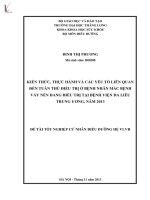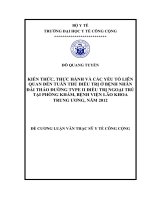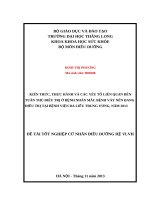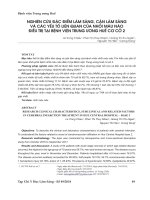Đặc điểm lâm sàng, cận lâm sàng và các yếu tố liên quan với chảy máu tiêu hóa ở bệnh nhi sốt xuất huyết dengue tt tiếng anh
Bạn đang xem bản rút gọn của tài liệu. Xem và tải ngay bản đầy đủ của tài liệu tại đây (158.44 KB, 31 trang )
MINISTRY OF EDUCATION AND TRAINING
MINISTRY OF DEFENSE
VIETNAM MILITARY MEDICAL UNIVERSITY
LE MINH DUNG
CLINICAL, SUBCLINICAL CHARACTERISTICS AND FACTORS
ASSOCIATED WITH GASTROINTESTINAL BLEEDING IN
DENGUE PEDIATRIC PATIENTS
Major:
No:
Internal medicine
9 72 01 07
SUMMARY OF DOCTORAL DISSERTATION
HA NOI-2020
THE RESEARCH WAS COMPLETED AT
2
MILITARY MEDICAL UNIVERSITY
Instructor:
1. Nguyen Duy Thang, Ph.D., Associate Professor
2 Nguyen Quang Duat, Ph.D., Associate Professor.
Reviewer 1: Dao Van Long, Ph.D., Professor
Reviewer 2: Nguyen Van Kinh, Ph.D., Professor
Reviewer 3: Vu Van Khien, Ph.D., Associate Professor
The dissertation was protected at the school-level council
At …… , ………. 2020
The dissertation can be found in:
2
3
1.
2.
3
Vietnam National Library.
Military Medical University Library.
4
INTRODUCTION
Dengue hemorrhagic fever is a tropical infectious disease that
often leads to a pandemic due to the absence of vaccines and unable
to control the transmission vectors. According to the World Health
Organization (WHO), about 2.5 billion people are at risk of dengue
virus infection worldwide. Among that, approximately 390 million
cases of dengue infection per year. It is estimated that the majority of
the subjects (about 95%) are children under 15 years old. In
particular, in Vietnam, Dengue hemorrhagic fever is the main cause
of death among the most common infectious diseases.
The clinical and subclinical characteristics of Dengue
hemorrhagic fever in children are diverse causing difficulties in
diagnosing. Bleeding in general and gastrointestinal bleeding, in
particular, are common symptoms in Dengue patients who have
warning signs and shock. Children with severe or prolonged shock
usually have severe bleeding.
To improve the effectiveness of early detection, giving
prognosis and intervention for Dengue-infectied pediatric patients,
we conducted the study with the following aims:
1. To assess clinical and subclinical characteristics of Dengue
pediatric patients with gastrointestinal bleeding in Nhi Dong 1
Hospital from 12/2014 to 12/2015.
2. To evaluate the relationship between gastrointestinal
bleeding and clinical, subclinical characteristics and virus type of
Dengue pediatric patients at Nhi Dong 1 Hospital from 12/2014 to
12/2015.
4
5
New contributions to the dissertation:
This is the first study in Vietnam to conduct with complete,
systematic, detailed information about gastrointestinal (GI) bleeding in
Dengue pediatric patients. The study has shown some clinical,
subclinical characteristics of gastrointestinal bleeding in Dengue
pediatric patients. In which the main symptoms are abdominal pain
(78%) and fatigue (74.6%). In addition, the most common symptoms are
vomiting blood (hematemesis) (93.2%) and blood in the stomach sonde
(86.4%) and abdominal pain (78%). The common subclinical symptoms
are PT rate < 60% ( 81.3%) and APTT time > 60 seconds (81.4%).
The study identified some factors associated with GI bleeding in
Dengue pediatric patients. There are 3 related symptoms: abdominal pain,
lethargy, fatigue. In addition, 5 physical symptoms that were related to GI
bleeding on univariate analysis are vomiting, bloating, neurological
disorders, edema, and nasal bleeding. There were 2 subclinical symptoms:
PT rate < 60% and APTT time > 60 seconds, more common and
statistically significant differences between GI bleeding and GI nonbleeding group (p <0.05). The GI bleeding group is mainly found in type
2, accounting for 66.1%. There are 2 clinical symptoms (abdominal
obstruction and edema) in patients with GI bleeding appearing with a
significantly higher incidence in type 2 than type 1.
Dissertation structure
A total of 117 pages including 2-pages of issue sets; Chapter 1 is
Overview of 33 pages; Chapter 2 is Object and Methodology having
5
6
19 pages; Chapter 3 is Research Results including 28 pages; Chapter
4 is Discussion 32 pages; Conclusion lasts 2 pages and the last page
for the proposal.
The thesis has 41 tables, 7 figures and 6 charts, 122 references.
6
7
Chapter 1: OVERVIEW
1.1. Overview of gastrointestinal bleeding
1.1.1. Characteristics of gastrointestinal bleeding
Epidemiological characteristics of gastrointestinal bleeding
Acute gastrointestinal (GI) bleeding is a major cause of
hospitalization in the United States estimated 300,000 patients
annually. An annual incidence of upper GI bleeding is 40-150 per
100,000 people and the mortality rate accounts for 6-10%; while in
lower GI bleeding, that incidence is 20-27 per 100,000 people and
the mortality rate is 4% -10%.
In adults, the most common cause of GI bleeding is a gastricduodenal ulcer, accounting for 50% of GI bleeding cases in which the
rate of duodenal ulcer is higher than gastric ulcer.
1.1.2. Characteristics of gastrointestinal bleeding in children
1.1.2.1. Epidemiological characteristics of gastrointestinal bleeding
in pediatric patients
Up to 95% of upper GI bleeding cases in children are
associated with GI mucosa damaging and esophageal varices. Unlike
upper GI bleeding, many cases of lower GI bleeding usually cease.
Bancroft et al. determined that vomiting blood accounted for only 5%
of patients (327 of 6,337) with indications for gastroduodenal
endoscopy in children. According to Bensouda et al., a study in French
population estimates that upper GI bleeding occurs in 1 to 2 children
per 10,000 children per year. Among that, exposure to nonsteroidal
anti-inflammatory drugs (NSAIDs) plays a role in 36% of these cases.
7
8
1.1.2.2. Clinical and subclinical characteristics of gastrointestinal
bleeding in Dengue pediatric patients
Not only the symptoms of Dengue hemorrhagic fever, but
other signs below also suggest upper GI bleeding:
Signs: There are often warning signs, especially in older children.
Clinical signs:
- Vomiting blood; bloody stools.
- Initial clinical assessment: a quick assessment of general
condition especially the vital signs and level of their consciousness.
- Severe GI bleeding has the following symptoms: fast pulse;
low blood pressure; pale in skin color; sweatings and cold limbs;
signs of cerebral ischemia; and shock.
Subclinical signs:
- Tests: full blood count; prothrombin time and thromboplastin
time, fibrinogen; blood type identification; liver function test (AST,
ALT, protein, and albumin), renal function test (urea and creatinine).
- Angiography, radionuclide scan, gastroduodenal endoscopy, and
colonoscopy.
1.1.2.3. Definitive and differential diagnosis of gastrointestinal
bleeding in pediatric patients
Definitive diagnosis:
Determine the blood in the substance of vomiting or stool.
"Bedside technique" to determine hemoglobin (eg Hemocult,
Gastrocult, SmithKline Diagnostics) or quick test of Fecal Occult
Blood - FOB to determine blood in the stool.
Differential diagnosis:
8
9
Vomiting blood: GI bleeding should be differentiated from the
lesions that cause bleeding in the nose and throat.
Children with black feces also need to distinguish from
children taking drugs that make black feces (bismuth, iron, activated
carbon) or constipation for a long time.
1.1.2.4. Diagnosis causes of gastrointestinal bleeding by age group
Upper GI bleeding due to various reasons, especially by age
group. Common gastric ulcer, rupture of the esophagus varies,
Mallory - Weiss, gastroesophageal reflux. It can be divided into three
groups.
Lower GI bleeding: Common intussusception, Meckel’s
diverticulum,
anal
fissure,
polyps
in
the
colon,
vascular
malformation.
1.2. Dengue hemorrage fever characteristics in pediatric patients
1.2.1. The characteristics of Dengue hemorrhagic fever in pediatric
patients
Dengue hemorrhagic fever has a variety of clinical
manifestations, rapid progression. The disease usually starts suddenly
and progresses through three stages: the fever stage, the dangerous
stage, and the recovery phase.
According to WHO (2009), the disease was divided into three
levels: Dengue hemorrage fever, Dengue hemorrage fever with
warning signs, severe Dengue hemorrage fever.
1.2.2.
Pathogenesis
of
Dengue
hemorrhagic
gastrointestinal bleeding in Dengue hemorrhagic fever
9
fever
and
10
Although many researchers around the world have researched
deeply on the virology and pathogenesis of dengue fever, there has
been no consensus to date. Currently refers to the following
phenomena: plasma leakage due to increased vascular permeability,
coagulopathy, and liver damage during Dengue hemorrhagic fever.
1.2.3. Relationship between Dengue virus type and gastrointestinal
bleeding
Recent studies indicate that different types of viruses, even
subtypes, tend to cause different severity.
1.3. The situation of study on gastrointestinal bleeding in dengue
patients in the world and Vietnam
Research conducted by ShubhankarMishra et al. (2016) found
that stomach bleeding accounted for 76.9% in pediatric patients
diagnosed with severe dengue hemorrhagic fever. According to Bach
Van Cam (2006), the proportion of pediatric patients with
gastrointestinal bleeding is 45.1%. Research conducted by Huynh
Nguyen Duy Liem (2010) shows that the proportion of pediatric
patients with gastrointestinal bleeding is 23.9%.
Chapter 2: OBJECTIVES AND RESEARCH METHODS
2.1. Object, location and time of study
2.1.1. Research subjects
The study participants were 119 children diagnosed with
Dengue infection according to the Ministry of Health criteria in 2011
and divided into two groups.
10
11
Group of Dengue patients with GI bleeding: Including 59
children, from 2 months to 15 years diagnosed with severe dengue
hemorrhage, inpatient treatment, and diagnosed with gastrointestinal
bleeding.
Group of Dengue patients without GI bleeding: Including 60
patients from 2 months to 15 years old diagnosed with dengue
hemorrhage, inpatient treatment, without signs and symptoms of GI
bleeding.
Exclusion criteria:
- Patients with a history of nose bleed, root bleeding, GI bleeding
before the study, and peptic ulcer disease were excluded.
- Patients who took substances that make black feces such as taking
medicines containing iron, bismuth, Chinese medicine also excluded.
- Children aged less than 2 months.
2.1.2. Research time and location
The study was conducted at Nhi Dong 1 Hospital, Ho Chi Minh City
between 12/2014 – 12/2015.
2.1.3. The process of selecting research subjects
When the patient is admitted to the hospital, select the patient
following the criteria for selection and exclusion criteria. Monitor
and record if there is GI
bleeding, performing subclinical tests
according to the study criteria, and recording. At the same time
choose a case of dengue diagnosis following the criteria for selection
and exclusion criteria but without GI bleeding, which corresponds to
the age and gender included in the study sample, perform all tests
11
12
according to the study criteria study, record in the medical record the
group without GI bleeding.
2.2. Research Methods
2.2.1. Research design
- Apply the cross-sectional descriptive research method
- All patients studied were thoroughly questioned and examined,
performing tests, recording in the same medical record form (with the
attached appendix).
2.2.2. Sample size and sampling methods
Conducting a cross-sectional descriptive study, we apply the
formula of calculating the sample size for descriptive research to
estimate a ratio. We get the minimum sample size, large enough and
reliable enough to be 58 Dengue patients. In fact, we studied 59
dengue patients with GI bleeding from 12/2014 to 12/2015. In
addition, to be comparable, we also studied 60 patients diagnosed
with dengue hemorrhagic fever but without clinical manifestations of
GI bleeding.
Regarding the sampling method, we use the whole sampling method.
2.3. The content and research targets
The patient is carefully examined by the physical examination to
identify epidemiological factors, signs, and symptoms.
- Research variables: Age, gender, duration of illness.
- Clinical signs: pulse, fever, hemodynamic condition, skin, and
mucous manifestations, GI bleeding manifestations both inside and
outside of the digestive tract. Symptoms of another system such as
respiratory, neurological, musculoskeletal also record.
12
13
- Subclinical criteria: full blood count; biochemical test; coagulation
function test; using RT - PCR in virus identification.
2.4. Processing and analyzing data
The data is processed by the method of medical statistics, using SPSS
software 13.
2.5.
Ethical issues in research:
Compliance with ethical regulations in research.
2.6. Some limitations of the study
Subjects selected for the study were those of the regional
end-line hospital, so the pediatric patients were often worse than
those at lower levels, private clinics or clinics or home treatment
subjects. Therefore, our study has not assessed all levels and clinical
symptoms of subjects with Dengue virus concerning GI bleeding.
The number of patients selected is not large and the study time
is not long enough, so there is no comprehensive analysis of the virus
type and the relationship with clinical manifestations and GI bleeding
status.
The ethics committee of Nhi Dong 1 Hospital does not approve GI
endoscopy in pediatric patients with Dengue hemorrhagic fever, so
we do not perform gastrointestinal endoscopy for diagnosis (the
diagnosis is only based on clinical and blood test).
Chapter 3: RESEARCH RESULTS
3.1. Clinical and subclinical characteristics of the gastrointestinal
bleeding group
13
14
3.1.1. General characteristics of the group with gastrointestinal
bleeding
Table 3.5 Distribution of gastrointestinal bleeding group by age group
Age group
Quantity (n=59)
Percentage (%)
≤ 1 years old
2
3,4
>1 – 5 years old
16
27,1
6 – 10 years old
29
49,2
11 – 15 years old
12
20,3
Total
59
100
± SD
7,29 ± 3,38
Table 3.1 shows that: among the GI bleeding group, the most
common age group is 6-10 years old, accounting for 49.2%. The
average age of patients is 7.29 ± 3.38 years old.
3.1.2. Clinical characteristics of the group with gastrointestinal
bleeding
Table 3.4 Clinical characteristics of gastrointestinal bleeding
symptoms (n = 59)
Gastrointestinal bleeding symptoms
Quantity
Percentage (%)
Vomiting blood
55
93,2
Black stools
15
25,4
Blood in the stomach sonde
51
86,4
Table 3.4 shows that: among children with GI bleeding, the
symptoms of vomiting blood accounted for the highest rate (93.2%);
followed by placement of gastric sonde with blood accounted for
14
15
86.4% and symptoms of black stool defecation accounted for the
lowest proportion (25.4%).
Table 3.5. Features of symptoms upon admission (n = 59)
Symptoms
Quantity
Percentage (%)
Fever
58
98,3
Epigastric pain
46
78,0
Languid
44
74,6
Fatigue
23
38,9
Anorexia
11
18,6
Headache
3
5,1
Myalgia
2
3,4
Pain behind the eye orbit
1
1,7
Table 3.5 shows that: In particular, except for fever symptoms
(98.1%), in the group with GI bleeding, there are 3 symptoms:
abdominal pain (78.0%), languid (74.6%), fatigue (38.9%), the rate
of occurrence is higher than other symptoms.
Table 3.6. Physical symptom characteristics on admission (n = 59)
Characteristics
Quantity
Percentage
(%)
Respiratory failure
56
85,0
Pleural effusion
53
89,8
Circulatory failure
51
66,4
Vomitting
55
93,2
15
16
Hepatomegaly
48
81,4
Cold limb
47
79,7
Abdominal distention
46
78,0
Neurological disorders
18
30,5
Edema
13
22,0
Table 3.6 shows that common physical symptoms, when hospitalized in
GI bleeding group, include: respiratory failure (85.0%), pleural effusion
(89.8%), circulatory failure. (66.4%), vomiting (93.2%), hepatomegaly
(81.4%), cold limb (79.7%), abdominal distention (78.0%).
Table 3.7. Bleeding outside digestive organs (n = 59)
Signs of bleeding
Quantity
Percentage (%)
Subcutaneous hemorrhage
44
74,6
Nasal bleeding
19
32,2
Root bleeding
18
30,5
Table 3.7 shows that the manifestations of bleeding signs outside the
digestive tract can be seen as the most common subcutaneous
hemorrhage (74.6%), followed by nasal bleeding (32.2%).
16
17
3.1.2.
Subclinical
characteristics
of
the
gastrointestinal bleeding group
Table 3.9. Hematological and coagulation test characteristics upon
admission
Index
Quantity
Percentage (%)
Red blood cells
Decresed
8
13,6
Increased
43
72,8
Decresed
38
65,5
Increased
12
20,7
Decresed
54
91,5
Light
1
1,8
Fit
7
13,0
Heavy
7
13,0
Very heavy
39
72,0
Moderate reduction
3
5,1
Severe reduction
4
6,8
Very severe reduction
52
88,1
Decresed
19
32,2
Increased
5
8,5
48
81,3
Leukocytes
Plateau at admission
Platelets at lowest
Hematocrit
Prothrombin
< 60 %
17
18
APTT
> 60 seconds
48
81,4
Table 3.9 shows: 72.8% of children with GI bleeding have increased
erythrocyte upon admission. In the group of pediatric patients with
bleeding GI bleeding 65.5%, the number of white blood cells
decreased. 91.5% of subjects had GI bleeding with thrombocytopenia.
At the time of the lowest platelet count, 100% of the patients in the GI
bleeding group had values lower than normal. 32.2% of pediatric
patients with hematocrit bleeding decreased. 81.3% of pediatric
patients with GI bleeding had a PT rate < 60%. 81.4% of pediatric
patients with GI bleeding had APTT > 60 seconds.
3.2. Relationship between gastrointestinal bleeding with clinical,
subclinical and viral symptoms in Dengue dengue patients
3.2.1. Clinical, subclinical characteristics and virus identification
results of research subjects
Table 3.22. Distribution of dengue virus type due to gastrointestinal
bleeding
GI non-
GI bleeding
Total
(n=59)
(n=119)
n (%)
n (%)
n (%)
Type 1
40 (66,7%)
13 (22,0%)
Type 2
9 (15,0%)
39 (66,1%)
Type 3
1 (1,7%)
2 (3,4%)
Assay
18
bleeding
(n=60)
p
53
<
(44,5%)
0,01
48
(40,4%)
3 (2,5%)
19
Type 4
10 (16,7%)
15
5 (8,5%)
(12,6%)
Table 3.22 shows that: in the group of children with GI bleeding, the
highest is type 2, accounting for 66.1%; while in the group without
major GI bleeding, type 1 account for 66.7%. The difference is
significant with p <0.001.
Table 3.23. Multivariate regression analysis of factors related
to gastrointestinal bleeding
Index
Nasal
bleeding
Stomachach
e
p; OR; 95%CIOR
0,01; 3,09 (1,2-8,0)
0,003; 3,3 (1,4-7,6)
Languid
0,000; 11,7 (4,2-33,0)
Fatigue
0,000; 5,7 (2,0-16,6)
Vomitting
0,002; 5,4 (1,6-18,3)
Tympanites
0,000; 8,3 (3,2-21,3)
Neurologica
l disorders
0,000; 12.7 (2,5-65.1)
Edema
0,02; 3,96 (1,2-13,4)
Red blood
0,11; 0,34 (0,08-1,37)
19
OR*; 95%CIOR; p
3.09; (0,73-13,1);
0,125
2,7; (0,65-11,3);
0,172
11,9; (3,2-43,7); <
0,001
1,96; (0.46-8,39);
0,365
15,1; (1,44-158,1);
0,0023
10,12; (2,75-37,6);
0,001
4,29; (0,63-29,4);
0,138
4,57; (0,59-35,4);
0,146
1,5; (0,12-18,4);
20
cells
Leukocytes
Plateau
0,75
0,37; 1,56 (0,58-4,19)
0,09; 0,18 (0,02-1,68)
Hematocrit
0,79; 1,1 (0,53-2,3)
ALT
0,86; 1,08 (0,4-2,63)
0,5; (0,1-2,5); 0,395
2,03; (0,12-35,0);
0,625
1,1; (0,3-3,7); 0,93
1; (0,99-1,112);
0,207
Table 3.23 shows that, in the regression multivariate analysis model, the
three signs of which one is a symptom of symptoms are Languid/ fatigue
(OR = 11.9) and two clinical signs are: abdominal distention (OR =
10,12) and vomiting (OR = 15,1) are considered to be risk factors
associated with clinical GI bleeding.
The value of the regression multivariate analysis explained up to 85.22%
of cases with clinical GI bleeding and clinically significant with p
<0.001 (LR chi-squared = 85.22; p <0.001. Likelihood = -39.16).
3.2.2. The relationship between some common characteristics and
the type of virus in the study subjects
Table 3.24. Relationship between gender and Dengue virus type
Female (n=55)
Male (n=46)
n
%
n
%
Type 1
25
45,5
28
60,9
Type 2
30
54,5
18
39,1
Total
55
54,5
46
45,5
Serum type
20
p
0,122
21
Table 3.24 shows that the prevalence of type 1 in males is 60.9%
more than in females (45.5%) and vice versa the incidence of type 2
in females is 54.5% more than males (39.1% ), however, the
difference is not statistically significant with p> 0.05.
21
22
3.2.3. Relationship between some clinical characteristics and virus
types in the study subjects
Table 3.27. Relationship between physical symptoms and the type of
virus
Physical
symptoms
Respiratory
failure
Pleural
effusion
Circulatory
failure
Vomit
Hepatomega
ly
Cold limb
Tympanites
Neurological
disorders
Edema
Diarrhea
Temperature
Median
Min-Max
22
GI bleeding
(n=52)
Týp 11
(n=13)
12
(92,3)
11
(84,6)
10
(76,9)
12
(92,3)
11
(84,6)
8
(61,5)
7
(53,9)
3
(23,2)
0
2
(15,4)
38,4
38 –
41
Týp 22
(n=39)
37
(94,9)
35
(89,7)
35
(89,7)
36
(92,3)
32
(82,5)
33
(84,6)
34
(87,2)
11
(28,2)
13
(33,3)
GI non-bleeding
(n=49)
p
(p12;
p34)
Týp 13
(n=40)
Týp 24
(n=9)
37 (92,5)
8 (88,9)
0,59; 0,57
32 (80)
8 (88,9)
0,63; 0,47
35 (87,5)
6 (66,7)
0,35; 0,15
32 (80)
4 (44,4)
1; 0,043
33 (80)
6 (66,7)
0,6; 0,36
29 (72,5)
7 (77,8)
0,12; 0,55
13 (32,5)
3 (33,3)
0,01; 0,62
2 (5,0)
0
0,51; 0,66
2 (5,0)
0
0,02; 0,66
6 (15,4)
7 (17,5)
0
1; 0,32
38,4
38,4 –
40
39,0
38,4 39,1
38,4
38,4 40
0,18; 0,35
23
Table 3.27 shows that: in the Dengue hemorrhagic fever group of
pediatric patients with GI bleeding, abdominal distention and edema
were statistically significant differences between type 1 and type 2.
Chapter 4: DISCUSSION
4.1. Clinical and subclinical characteristics of gastrointestinal
bleeding in dengue patients
Age is an important factor affecting patients with Dengue
infection. The highest rate of hospitalization and death of Dengue
infection is in children and the elderly. The risk of death in children
from the second Dengue infection is nearly 15 times higher than for
adults. Among GI bleeding, the most common age group was 6-10
years, accounting for 49.2%. The average age of disease is 7.29 ±
3.38 years old (the lowest is 10 months old - the highest is 15 years
old).
In this study, we found that except for fever symptoms, in the group
with GI bleeding, there were 3 symptoms: abdominal pain (78%),
languid (74.6%), fatigue (38, 9%), have a higher incidence than other
symptoms (Table 3.5).
The incidence of abdominal pain in dengue fever also varied
by study. Gupta B.K. Research. et al. showed that the rate was 32.9%,
while this rate was only 4.15% in the study of Chandrasekaram S. et
al. in Sri Lanka in 2009. The proportion of patients with abdominal
pain in the group GI bleeding in our study is higher than in some of
the above studies.
Some symptoms appear in subjects with GI bleeding such as
myalgia and eye pain; skin flushing, however, appears only in small
23
24
numbers (Table 3.5). Myalgia is a common symptom associated with
Dengue infection. Symptomatic sore eyes have also been described in
several studies, in which the cause of this symptom is thought to be
due to subconjunctival hemorrhage, or retinal macular damage,
stellar neuritis, and hemorrhage retinal.
These signs can be considered as early signals for the risk of
gastrointestinal bleeding, and are valuable for the physician to take
further measures to serve the definitive diagnosis. However, these are
only symptoms reflecting from the patient's senses, so they are not of
high value in diagnosis and prognosis but only stop at the initial
remarks.
When examining physical symptoms in subjects with
gastrointestinal bleeding, we noticed a prominent occurrence of the
following symptom groups: vomiting (93.2%), hepatomegaly (81,
4%), cold at limbs (79.7%), abdominal distention (78.0%),
neurological disorders (30.5%), edema (22.0%) (Table 3.6).
Neurological
disorders
in
Dengue
infection
have
many
manifestations including consciousness disorder, stiffness, focal
neurological signs or seizures. Edema is a characteristic symptom of
dengue hemorrhagic fever occurring before the progression of
hemorrhage, in which most bleeding occurs in people infected with
the second dengue virus.
Signs of subcutaneous hemorrhage accounted for the highest
proportion (74.6% of Table 3.7), followed by nose bleeds (32.2%)
and root bleeding (30.5%). Manifestations of bleeding include a
positive test of Garo, subcutaneous hemorrhage, bruising to nasal
24
25
bleeding, and bleeding of the root to a severe degree, GI bleeding.
The rate of subcutaneous hemorrhage in our study is lower than that
of other authors. Research by Bach Van Cam and colleagues showed
that hemorrhagic manifestations are very diverse with subcutaneous
hemorrhage accounting for 93.33%. In the study of author Nguyen
Thanh Hung and colleagues recorded 244 cases of subcutaneous
hemorrhage over 245 cases of dengue in infants, accounting for
99.6%. A study by Chuansumrit A. et al. (2000) of 160 patients with
Dengue aged 10-14 years at a hospital in Thailand showed that 88
patients, accounting for 55% with hemorrhagic manifestations, of
which 37, 9% bleeding under the skin, 31.5% epistaxis, 11.2%
vomiting blood, 9.2% bleeding tooth. The reason for this difference is
due to the influence of many factors such as the age of disease, the
clinical form of dengue, the subjects selected for the studies were
different.
A new feature of our study is to point out some clinical
symptom related to GI bleeding in pediatric patients with Dengue
hemorrhagic fever, including symptoms such as abdominal pain,
lethargy, fatigue; and physical symptoms such as vomiting, abdominal
distention, neurological disorders, edema, blue skin, fever-shock, nasal
bleeding. At the same time, the research results also show that
although some common symptoms in Dengue hemorrhagic fever are
not warning signs for GI bleeding such as fever, subcutaneous
hemorrhage, hepatomegaly, shock ...
Our study showed that children with the prothrombin rate
<60% in the group with GI bleeding accounted for the majority
25









